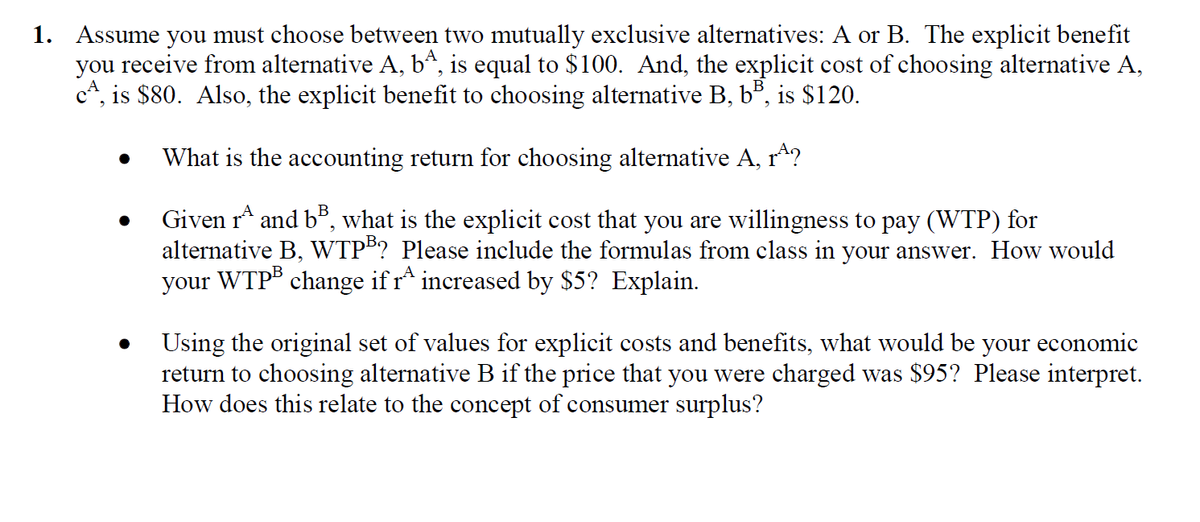Assume you must choose between two mutually exclusive alternatives: A or B. The explicit benefit you receive from alternative A, bª, is equal to $100. And, the explicit cost of choosing alternative A, c, is $80. Also, the explicit benefit to choosing alternative B, b", is $120. What is the accounting return for choosing alternative A, r^? Given r and b³, what is the explicit cost that you are willingness to pay (WTP) for alternative B, WTP®? Please include the formulas from class in your answer. How would your WTP change if r* increased by $5? Explain. Using the original set of values for explicit costs and benefits, what would be your economic return to choosing alternative B if the price that you were charged was $95? Please interpret. How does this relate to the concept of consumer surplus?
Assume you must choose between two mutually exclusive alternatives: A or B. The explicit benefit you receive from alternative A, bª, is equal to $100. And, the explicit cost of choosing alternative A, c, is $80. Also, the explicit benefit to choosing alternative B, b", is $120. What is the accounting return for choosing alternative A, r^? Given r and b³, what is the explicit cost that you are willingness to pay (WTP) for alternative B, WTP®? Please include the formulas from class in your answer. How would your WTP change if r* increased by $5? Explain. Using the original set of values for explicit costs and benefits, what would be your economic return to choosing alternative B if the price that you were charged was $95? Please interpret. How does this relate to the concept of consumer surplus?
Chapter17: Capital And Time
Section: Chapter Questions
Problem 17.7P
Related questions
Question

Transcribed Image Text:1. Assume you must choose between two mutually exclusive alternatives: A or B. The explicit benefit
you receive from alternative A, bª, is equal to $100. And, the explicit cost of choosing alternative A,
c*, is $80. Also, the explicit benefit to choosing alternative B, b", is $120.
What is the accounting return for choosing alternative A, r^?
Given r and b", what is the explicit cost that you are willingness to pay (WTP) for
alternative B, WTP"? Please include the formulas from class in your answer. How would
WTPB change ifr^ increased by $5? Explain.
your
Using the original set of values for explicit costs and benefits, what would be your economic
return to choosing alternative
How does this relate to the concept of consumer surplus?
if the price that you were charged was $95? Please interpret.
Expert Solution
This question has been solved!
Explore an expertly crafted, step-by-step solution for a thorough understanding of key concepts.
This is a popular solution!
Trending now
This is a popular solution!
Step by step
Solved in 2 steps with 4 images

Recommended textbooks for you


Managerial Economics: Applications, Strategies an…
Economics
ISBN:
9781305506381
Author:
James R. McGuigan, R. Charles Moyer, Frederick H.deB. Harris
Publisher:
Cengage Learning


Managerial Economics: Applications, Strategies an…
Economics
ISBN:
9781305506381
Author:
James R. McGuigan, R. Charles Moyer, Frederick H.deB. Harris
Publisher:
Cengage Learning